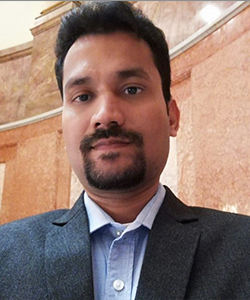Deepak Singhal is a technocrat with over 20 years of experience across domains like cloud computing, JAVA programming, and other emerging technologies like AI and ML, with a passion for entrepreneurship. As a certified Big Data expert, Security, Alexa specialist and AI designer, Deepak has worked with a vast number of tech and non-tech start-ups as well as with leading international giants, including IBM, Integral Development Corporation (India and U.S). Currently, he is working with Capgemini, where he is the Enterprise Architect Director for DEMS (Digital Engineering and Manufacturing Services) Business.
So far, cloud computing has been a buzzword for most of the emerging technology trends, across sectors. Internet of Things (IoT) and the surge in connected devices leading to smart homes, smart cities, and AI-powered innovations, are all said to be driven by Cloud. The same now holds true for the Automobile Technology segment. Automobile segment has not seen much innovation in the last century after Ford, but this decade would cover up all that shortfall. From building stronger, higher capacity engines to now changing focus on creating smarter cars, EVM and even AI-powered driverless cars, the segment has been now innovating in a real sense, and adopting the best in the emerging technology, at a fast pace. Vehicle-to-everything (V2X) is a term used for a group of technologies powering innovation that is set to transform not only the automobile segment but the very concept of smart travel!
What is V2X or Connected Vehicles?
Put merely, Vehicle-to-everything or V2X is an integrated communication system that allows a smart automobile to be connected to its environment, always. All the communication cannot go via Cloud always because of possible high latency and un-availability of the internet. The advent of 5G will reduce this problem to a great extent. These are also known as Connected Vehicles and typically comprise of automobiles with Interactive Advanced Driver-Assistance Systems (ADAS’s) and Cooperative Intelligent Transport Systems (C-ITS) and are designed to enhance ‘situation awareness’ and to identify and avoid traffic accidents. In other words, Connected Vehicles deploy intelligent communication that can be useful to solve traffic woes, enhance road safety, and offer seamless in-transit infotainment, advanced parking assistance and roadside assistance. It is also useful for remote diagnostics, and telematics for autonomous self-driving vehicles, and global positioning systems (GPS).
Largely, connected vehicles comprise of Vehicle-to-infrastructure (V2I), Vehicle-to-Network (V2N), Vehicle-to-Vehicle (V2V), Vehicle – to- Pedestrian (V2P), Vehicle –to- Device (V2D), and Vehicle-to-grid (V2G) connectivity. The DSCR – a WLAN based V2X communication, is the simplest form of connected vehicle network and is useful to ensure efficient V2V and V2I communication in remote areas. The 3GPP or Cellular V2X utilises the cellular data connectivity and communication network that offers an advanced, more sophisticated, two-way communication for V2I, V2V, V2D and V2N interactions.
Although nascent right now, the V2X is globally emerging as one of the smartest technology applications that efficiently combines AI, Data Analytics, Smart Infrastructure and IoT, with the best in automobile technology. As per a report by Stratistics MRC, the Global Automotive V2X Market was estimated to be USD 341.22 million as of 2018 and is expected to grow at a CAGR of 42.1% over the next decade, to reach USD 8060.79 million, by 2028. Factors like rising traffic congestion, need to curtail environmental hazards due to emission, need for intelligent navigation and smart transportation facilities powered by access to 5G connectivity, and road safety, are some of the key motivators for the growth of the V2X market.
Role of Cloud in the Connected Vehicle Ecosystem:
One of the key features of connected vehicles is the two-way communication that translates into a lot of data, exchanged consistently over a seamless network. Connected vehicles not only share information about themselves but also capture lots of sensory information from its surroundings, especially data generated by cameras, and radars, all of which needs to be adequately aggregated, analysed, and shared in real-time to maintain a consistent V2X dynamics. If done singularly or in a disconnected method, it can reduce the efficiency of the network and render the entire technology redundant.
This can be avoided by employing Cloud connectivity, to ensure the data collected is not only effectively stored and utilised but can also be a game-changer in designing future technology innovations. Using intelligent insights into the geographical, environmental and consumer usage patterns, over a long period, Automotive V2X communication systems connected to Cloud can fuel the future innovations in automobile technology. It also helps deal with cyber-security concerns, while assisting automotive manufacturers to a real-time information feed on varied parameters of vehicle performance, to facilitate efficient technology development.
Apart from these, the Cloud-connected V2X has been instrumental in:
- The development of ‘software-defined’ vehicles, where ‘isolated automobiles’ are now converted into hyper-connected and constantly communicating network of smart transportation
- Helping automobile manufacturers to effectively leverage the infinite scalability of the internet and the potential of IoT to deliver progressive, next-gen features to connected vehicles, and
- Transforming the autonomous Vehicle (AV) value chain, using data-driven insights to enhance the user experience, safety, and efficiency of connected vehicles and thereby transform the technology space for innovative mobility solutions.
- Sending petabytes of data generated by vehicles to Cloud. This helps us to build complex machine learning models on Cloud using this humongous data and then deploy models on Edge inside the car. Hence, all heavy loading is done by Cloud and models deployed on Edge inside the car can take spontaneous decisions.
While the above factors paint a convincing picture, the cloud connectivity and V2X communications technology are yet to address challenges around integrated data collections, seamless network support, and access to high-end connectivity bandwidth across terrains. Despite this, however, it would be true to state that the future of smart automotive technology is a dynamic and innovative phase of growth, where the car-to-cloud connectivity is set to redefine the idea of smart mobility while making road transport in urban and rural areas safer, energy-efficient and effective.
More About Deepak Singhal
 As an entrepreneur, Deepak initiated a few tech-enabled ventures, namely, craftedkids.com, a platform to showcase skills of young children, singledigitlottos.com, yourlocation.in and birthchums.com, all of which helped him to leverage his entrepreneurial skills, guided by a clear and enabling technology vision. Additionally, Deepak’s continuous quest for best in class business solutions led him to develop two Machine Learning products. The first, being a tracker of Stock market movements. The second is to show price comparisons of products across the different e-commerce portals based on images, leveraging his experience at Integral.
As an entrepreneur, Deepak initiated a few tech-enabled ventures, namely, craftedkids.com, a platform to showcase skills of young children, singledigitlottos.com, yourlocation.in and birthchums.com, all of which helped him to leverage his entrepreneurial skills, guided by a clear and enabling technology vision. Additionally, Deepak’s continuous quest for best in class business solutions led him to develop two Machine Learning products. The first, being a tracker of Stock market movements. The second is to show price comparisons of products across the different e-commerce portals based on images, leveraging his experience at Integral.
Apart from his own venture, Deepak has worked extensively with start-ups’ and has been instrumental in helping them build a robust tech infrastructure to create a lean, agile and scalable operating model. Prominent among this was Hopscotch, a leading eCommerce player in kids wears. They were able to leverage Deepak’s visionary guidance beyond just technology expertise, to scale up to the next level.
Deepak’s experience at Integral Development Corp. initiated his affinity towards the financial markets. He closely follows global Investment Banking, Stocks derivatives, FOREX, bonds, and commodities. In his passion for technology and curiosity to learn and be abreast of the latest innovations and development, Deepak keeps experimenting with various Cloud, Big Data & Machine Learning technologies and has also conducted webinars and training sessions.


